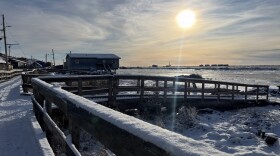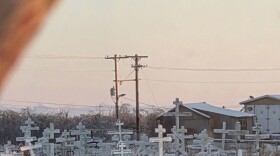-
The SBA announced on Dec. 11 that it had already approved nearly $3.7 million in loans to restore typhoon-damaged homes for 63 individuals.
-
Troopers said they received a report on Nov. 29 that 44-year-old Adrian Kailukiak had taken tribal police officer Gregory Karl hostage at gunpoint, but that another tribal police officer had been able to defuse the situation. More than two weeks later, Kailukiak's whereabouts remain unknown.
-
Kwigillingok, Alaska, has long grappled with erosion and flooding. Residents want to move to higher ground, further inland, especially after the remnants of Typhoon Halong damaged nearly every house.
-
The Kuskokwim River community of Napaskiak has regained power on Dec. 10 after four days without electricity.
-
The Federal Emergency Management Agency and State of Alaska say scam artists may pose as government officials, aid workers, or employees of insurance agencies.
-
Early season truck trails are being used on the lower Kuskokwim River, though they are not the official Kuskokwim Ice Road.
-
The Kuskokwim River community lost power late in the morning of Saturday, Dec. 6 due to electrical issues brought on by the ice storm over the weekend.
-
A collaboration between local organizations is collecting subsistence food donations to support storm-impacted families evacuated to Bethel or living in their home villages.
-
It wasn't in the budget, but Alaska Works Partnership managed to put together a construction workshop for Western Alaska disaster evacuees, who hope to use their new skills to rebuild after Typhoon Halong.
-
Troopers say several occupants of the home were able to escape, but that 78-year-old Xenia Black did not survive the blaze in the late evening hours of Nov. 27.
-
The National Guard said five service members will assist with administrative support; lawmakers and civil rights advocates worry that the move signals a ramping up of immigration enforcement operations in Alaska.
-
KYUK’s Sage Smiley spoke with Annie Rosenthal, a fellow with media outlet High Country News, about her recent reporting about the use of artificial intelligence for translations needed in disaster response, including its implications for tribal data sovereignty.















